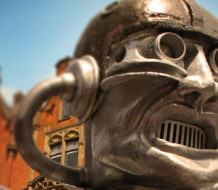When we think about children’s imagination, we think of them absorbed in a make-believe world or talking to an imaginary companion. Implicit in our thinking is the idea that the imagination is an escape vehicle that transports children to a non-existent world – one that they invent. The playroom floor is transformed into an ocean or cushions turned into wagons. Children with no friend at hand can invent a brave prince or a needy kitten as companions.
Developmental research supports this “escapist” view of the imagination. Toddlers begin to engage in pretend play autonomously. Whether parents join in or leave them to their own devices, they generally start to play pretend games in either case. Indeed, pretend play emerges with roughly the same developmental timetable across different cultures even if it gets elaborated in different ways. Also, when children pretend they do indeed set reality aside. If there is no real tea in the cup – they readily imagine it being there. Even if a stuffed animal is actually lifeless, they can still conjure up the creature’s thoughts and feelings.
This escapist view of the imagination implies that children use their imagination to abandon the real world, not to engage with it. It also suggests that the imagination is likely to wane as older children face the challenges of reality. But instead, I assert that rather than waning over time, children’s imagination changes over time. Rather than focusing on how to encourage children’s imagination, which actually needs little encouragement to appear, I propose instead that we seek to understand children’s imagination—what it is, how it changes and the role it plays in children’s development. Effectively, I propose a radically different “realist” view of the imagination. This alternative view might make the imagination sound constricted. But ultimately I think it does a better job of capturing its power and reach. The imagination is vital if children are to go beyond the confines of their narrow, first-hand experience. I begin with a pedestrian illustration.
Imagination Changes Over Time
We invited 2-year-olds to put a toy in one of several locations in a room – inside a cupboard, for example. Next, the children went to the room next door where half the children could look through a window back into the room they had just left. There they saw an adult move the toy from the cupboard to a box. The remaining children did not see this change. Instead, an adult came to tell them that she had moved the toy to the box. Both groups returned to the original room and were asked to find the toy. The 2-year-olds almost always searched correctly in the box if they had looked through the window. Apparently, they had taken note of the toy’s change of location as they watched. They did not go back to the cupboard.
Children who were only told about the change were less accurate. Young 2-year-olds often returned to the cupboard, ignoring what they had been told. But 2 ½-year-olds typically accepted what they had been told and searched for the toy in the box. So these children not only represented or imagined a world consistent with what the adult had told them but they treated that imagined world – remember they had never actually seen the toy put in the box – as the actual world. Here, we have a simple example of children using their imagination, not to escape from reality, but to guide their understanding of reality.
If we now fast-forward three or four years, we find that this capacity – to understand the real world via the imagination – has a wide-ranging impact on children’s thinking. We asked 5- and 6-year-olds about the kinds of things that exist. For example, we asked them if there really are germs. Almost all the children confidently said that germs exist. Indeed, they were as confident about the existence of germs as about the existence of creatures such as giraffes and camels. At first glance, this result is unsurprising. After all, children have been told that there are germs – and so why is it of any interest that they accept such claims? Again, we need to remember that there is a fundamental mismatch between what children are told and what they have seen for themselves. They may well have seen a giraffe or a camel but they have never seen germs. Yet they are equally confident about the existence of all of these creatures. Here too, we see that children accept that the real world does not match what they have seen for themselves. (For more on this research, see my book Trusting What You’re Told, published by Harvard University Press.)
In a further study, we asked 5- and 6-year-olds about the existence of special beings such as the Tooth Fairy or God. Most children confidently claimed that these special beings also exist. Taken together, the data from these studies suggest that children use their imagination – guided by what other people have told them – to construct a conception of the world that goes well beyond what they have seen. It includes scientific phenomena – and it includes non-scientific, special beings.
Arguably, the findings so far could be interpreted without invoking children’s imagination. Perhaps children listen to what they are told and trustingly file away some mental distillation (e.g., The toy is in the box; Germs exist; There is a Tooth Fairy). Then, when appropriate, they retrieve the relevant mental file and respond accordingly. By implication, talk of the imagination is otiose. Note that this line of thinking echoes the standard view of the imagination – that it is appropriate to invoke the imagination when someone invents a piece of make-believe but not when they simply register what they have been told about the way things are.
But the mental file metaphor does not do justice to the very active – and imaginative – fashion in which children make sense of what they are told. This is illustrated by a study carried out by Gabrielle Principe and her colleagues with the delightful title: “The Tooth, the Whole Tooth and Nothing but the Tooth.” Five- and 6-year-olds were asked to recall when they had received a visit from the Tooth Fairy. Some children were asked to recall what happened in a truthful manner (“I like children who tell exactly true stories…”) and some in a fun manner (“I like children who tell really fun stories…”).
Many of the children fully believed in the Tooth Fairy – they had no doubts about her existence. No matter whether they received the “truth” or “fun” instruction, these true believers asserted things that could not have actually happened on her visit, for example, “She flied in the window” or “My cat got her stinking fairy dust all over her fur.” They even said that they had witnessed these fantastical events: “I heard her close my window” or “She told me to go back to sleep” or “I sawed her tippie-toed into my room.”
Clearly, these true believers did not file away and retrieve a minimalist record of what they had been told about the Tooth Fairy. Rather they used what they had been told to create a richer mental schema. Thanks to their imagination, they reported her flying in through the window, closing it, walking on tiptoes, and issuing instructions – admittedly, all plausible elaborations on the Tooth Fairy’s alleged habits but nonetheless the product of children’s imagination rather than the narrative a parent might provide. Strikingly, such elaborations were more or less absent among Tooth Fairy skeptics – especially when they were asked to provide a truthful as opposed to a fun account.
Children Use Imagination to Understand What They are Told
These findings offer two strong arguments in favor of the “realist” account of the imagination. First, children bring their imagination to bear on what they are told – contrary to the idea that they file away an unembellished mental record. In their mind, they credit the Tooth Fairy with characteristics and capacities that nobody has actually told them about. Second, they are especially prone to do this with respect to a phenomenon that they take to be real. The children who were skeptical about the Tooth Fairy eschewed such fanciful elements. Indeed, even when tacitly prompted to use their imagination (“I like children who tell really fun stories…”) the skeptics were less inventive than the believers.
So far, I have talked about how the imagination infuses children’s ideas about where things are and what things exist. Does the imagination also infuse children’s ideas about causality? Many developmental psychologists think of children as little scientists who gradually make sense of the natural laws that determine what can and cannot happen. On this view, children’s imagination plays no obvious role in their ideas about causality. However, we have recently obtained results that undermine this child-as-scientist metaphor.
We began by asking if children differentiate between historical and fictional stories. Our working hypothesis was that children would need to use their imagination to make sense of both types because whether the story describes what happened to Abraham Lincoln or to Harry Potter, children have witnessed neither set of events. However, unlike historical stories, fictional stories often include magical elements. We wondered if children would use this clue to decide whether they were dealing with fact or fiction upon hearing a new story. We gave 5- and 6-year-old stories about an unfamiliar person, for example, a soldier they had never heard of before. One soldier story described events that could realistically happen whereas the other included magical elements – a sword that protected the soldier in any battle. Children concluded that the soldier who encountered only ordinary events was an actual person whereas the soldier with the invincible sword was make-believe. By implication, children of 5 or 6 years operate with the assumption that magic cannot happen in the real world. (For more on this study, see the article in Cognition.)
Later, we discovered that this analysis was too simple – it ignores the major impact that religion has on children’s thinking. We gave children quasi-biblical stories – novel stories that echoed the kind of miracle that occurs in the Bible. For example, the protagonist might wave his staff and create a pathway through an impassable mountain. Children’s reactions to these stories varied dramatically. Secular children – those attending public school and not going to church – thought of the protagonist as make-believe whereas children who had received a religious education thought of the protagonist as real. Essentially, the two groups differed in their conception of the real world – for the religious children it included the miraculous but for the secular children it did not. (For more on this study, see the article in Cognitive Science.)
In conclusion, these findings imply that we should not fret about any decline of imaginative ability, as children get older. The conception of reality that children adopt owes a great deal to their imagination. Children, and indeed adults, look at reality and come to interpret it within the deeper, underlying framework that their imagination constantly supplies – to help them understand what has happened next door, the existence of invisible agents, and what is possible and what is not.
Discussion Questions
1. Children believe in the existence of germs and the Tooth Fairy. Do they think of them as being equally real?
2. How far does education impact the development of the imagination?
Discussion Summary
The main goal of my essay was to offer a different conception of the imagination from the one that is commonly invoked in everyday discussion of pretense and imagination in early childhood. We typically invoke the imagination when we think of a child who is engaged in a fantasy world, whether that fantasy world is generated by the child or is found in a storybook, television program or via digital media. When framed in this way, discussion of how to nourish the child’s imagination often returns to the question of whether newer sources of input, especially from digital media, are displacing or confining other types of imaginative activity on the part of young children. Parents, educators and pediatricians express concern about this issue. In addition, concern is frequently expressed about the degree to which children who are absorbed by a make-believe world are muddled about the distinction between fantasy and reality, so that, for example, they take media depictions of a fantasy world to be depictions of reality.
My own research has led me to a more extended, and in certain respects, more radical conception of the imagination. As set out in my essay, I believe that children rely on their imagination not just to think about make believe or fictional worlds but also to think about and understand the real world. This claim follows from the fact that young children rapidly arrive at a conception of the world that goes much beyond what they have been able to observe first-hand. More specifically, young children learn about the past, including the childhood of their parents, the history of their local community, and major historical events. Their ability to think about such events depends critically on their ability to imagine events that they have been told about but not seen for themselves. Much the same argument applies to children’s understanding of science. Young children cannot easily observe many scientific phenomena – for example, the movements of the planets. As in the case of the historical past, their ability to understand these scientific phenomena depends on their ability to imagine what they have been told about but not observed directly. Finally, the argument also extends to religious phenomena. Children will hear religious claims made about events and phenomena that they cannot ordinarily observe for themselves. Here, too, children’s understanding will depend on their ability to imagine what they learn about.
Some reactions to my essay suggested that this radical view was not so easy to accept or digest. For example, one commenter stressed the amount of information that children are exposed to via digital media and speculated that “they have become overexposed to things which arouse their imagination out of proportion with what we would have imagined possible two decades back.” Yet such a comment discounts the possibility that nourishment of children’s imagination might enlarge their ideas about reality – the main thrust of my essay. Another comment implied that I had taken too narrow a view of the imagination by limiting it to a “lack of discrimination between real and pretend.” I sought to clarify that children’s mastery of this distinction was not my primary focus. As it happens, the psychological evidence indicates that children readily distinguish pretense from reality – even if they deploy their imagination to think about make-believe worlds as well as the real world.
The most fertile line of discussion focused on the extent to which children’s imagination and later creativity might be nourished by their ability to hold onto and believe in magical phenomena such as Santa Claus or the Tooth Fairy – with the corollary that denying the existence of such entities might limit later imagination and creativity. I emphasized that I know of no research showing that children’s imagination derives any special or distinct benefit from thinking about magical possibilities. Although such thinking prompts children to contemplate phenomena that are unexpected and counter-intuitive, there are plenty of non-magical, real phenomena that will likely stretch children’s imagination in the same way. For example, thinking about the relationship between the mind and the brain, or the existence of invisible forms of life such as bacteria, is also likely to prompt children to think about phenomena that are unexpected and counter-intuitive.
Two Big Questions suggest themselves in the wake of the above discussion. First, to the extent that young children can readily make a distinction between the world of make-believe and the real world, it is likely that the occasional confusions that they do display – for example, believing for several years of early childhood that there really is a Tooth Fairy – are mainly due to the “misleading” messages that they are given by well-intentioned adults. More generally, children’s receptivity to what adults tell them raises an important question about the extent to which children’s view of reality is intimately linked to what they have been told – whether or not they have any genuine, first-hand evidence for what they have been told.
A second, related question concerns the relationship between magic and miracles. Many children gradually abandon a belief in magic – including, for example, the Tooth Fairy, whereas they retain a belief in miracles, such as Creation. How can we explain this bifurcation?












It is a useful article not so much because of the imagination issue but because it raises a fundamental question of how to bring up kids. This question has become particularly a pressing one because children nowadays are exposed to so much through TV, radio, internet, video, mobile phones, ipads etc that they have become overexposed to things which arouse their imagination out of proportion with what we would have imagined possible two decades back. There is also the issue of to what extent we can continue to flood them with those gadgets which impact perhaps too much on their mental processes and to what extent this is damaging their immature nervous system. No doubt many in universities and elsewhere will conduct surveys but to what extent their findings will lead to better ways of impacting on children’s imagination remains to be seen. We will watch, in countries which are multireligious, how different religions provide an educational background that checks exposure to the effects of mass media and videogames. We will keep a close look at the declining performance of boys as compared to girls, analyse the data and write newpaper articles. Finally the best solution is a balanced educational recipe for our kids, one that will make them understand the challenges they will face and which gives them a good and healthy education Therefore what we need do is to sensitize parents on the modern trends of our environment and the impact on kids. But in the end let parents themselves decide how they want their kids to be as they grow up. Schools and universities should continue to provide the best educational curricula possible.
Limiting the concept of imagination to lack of cognitive discrimination between real and pretend seems unreasonably narrow. A broader view is suggested in Stuart Brown’s recent book on Play – How it Shapes the Brain, Opens the Imagination and Invigorates the Soul. One of my children chose to hold onto a “belief” in Santa Claus until he was eleven – at which time the concept morphed into the spirit of Christmas. My sense is this was a playful behavior and overall very positive.
On the question of religious education, Justin Barrett’s earlier BQO article (Are We Born Believnig In God) pointed out that all children naturally understand agency and by the age of five generally extrapolate this to a transcendant agency (God). If those children are not raised in a religious household where that concept is reinforced then it seems to fade over time to conform with the family culture.
Perhaps we shold encourage a sense of mystery and magic in the play of children – including beliefs in tooth fairies, super powers and transcendent agents. Evidence suggests they may be happier as adults. (http://www.dailymail.co.uk/femail/article-1358421/The-tantalising-proof-belief-God-makes-happier-healthier.html)
I did not make the narrow – and very dubious – claim that the imagination implies a “lack of cognitive discrimination between real and pretend”. The developmental evidence shows that young children master that distinction quite easily. For example, even children who have a relationship with an imaginary companion over weeks or months acknowledge that the companion is not a real person. So, here we have a straightforward example of young children distinguishing the pretend from the real. My claim was rather that the imagination has a double function – it underpins children’s engagement with the world of make-believe but it also underpins their engagement with the real world.
Thank you and fair enough. So perhaps it is important to ask – what is the difference between imaginary or magical imagination (playing with things or ideas that a child knows are not real) and what we might call exploratory imagination (engaging with things or ideas that a child believes are real). Are there consequences of one versus the other? Is there a synergy between the two? I had thought (perhaps wrongly?) that a child’s ability to hold onto and believe magical things would be important in encouraging imagination and creativity later in life. A corollary to that would be that discouraging those beliefs by consistently denying to a child that entities such as Santa Claus, or the tooth fairy were possible would discourage imagination and creativity. Are you aware of any evidence on these points?
Is there any evidence that encouraging children to believe in magical beings such as Santa Claus or the Tooth Fairy promotes their imagination whereas undermining such beliefs restricts their imagination? The research that I reviewed by Principe and her colleagues offers some help in answering this question. Children who believed in the Tooth Fairy were likely to deploy their imagination – and to offer a more elaborate and inventive account than Tooth Fairy skeptics when they described what had happened on her last visit. But I would be cautious in drawing any broader conclusions from this particular finding. Admittedly, the Tooth Fairy believers used their imagination in thinking about the Tooth Fairy’s visit but we have no evidence that this led them to use their imagination in a more active fashion when thinking about other special beings or other phenomena – the effect may have been specific to the Tooth Fairy. In addition, I would hesitate to conclude that children’s imagination derives any special or distinct benefit from thinking about magical possibilities. Admittedly, such thinking prompts children to contemplate phenomena that are unexpected and counter-intuitive – but there are plenty of non-magical, real phenomena that will likely stretch children’s imagination in the same way. For example, thinking about the course of evolution, or the relationship between the mind and the brain, or the existence of invisible forms of life such as bacteria, is also likely to prompt children to think about phenomena that are unexpected and counter-intuitive. So, although it is not inconceivable that the promotion of magical beliefs has a special role in promoting children’s imagination, there are good reasons for caution.
It is a subtle question as to whether belief in things that do not exist can encourage imagination in children. I’m sorry there is not more work on that. Is there an analogy, perhaps, in the adult literature on placebo and nocebo effects – believing in the effectiveness of a sugar pill has a positive effect on symptoms even when there is no medical basis for it. Similarly, those who read about and become preoccupied with disease symptons they read about may develop the symptoms. In this case the concern would be to have the belief oriented on positive rather than negative consequences. This would suggest that nice magic (good fairy, Santa Claus, a loving God) is a good thing for kids, and not so nice magic (bogeyman, vampires) is a bad thing.
But this still ducks the question – is magical thinking good for the imagination, or good in general, for kids? A follow-up question – when do we become more direct in encouraging evalution and testing of beliefs against experience – but in a way that encourages autonomy and self-esteem? We want adults that are thoughtful about what they believe and avoid “magical” thinking or mere dogma (whether religious or atheist). This requires critical thinking as well as imagination.
I did not make the narrow – and very dubious – claim that the imagination implies a “lack of cognitive discrimination between real and pretend”. The developmental evidence shows that young children master that distinction quite easily.
This point by P. Harris is fundamental where scientific psychologists have new science to explore in addition to what has been unravelled yet. We agree that children are able ot doing so and that lies at the heart of natural selection in the survival of the fittest. There is an inbuilt mechanism in the genetic system which ensures that generally children will make that difference so that they can focus on the realities of existence. So children are meant to be really pragmatic in their earliest ages but it is the environment, family, friends, school, the community, mass media, uncertainty, which come in prominently, act differentially on their minds. So finally we have a huge variety of persons. This brings me to my earlier point about education There has to exist an educational reality, like Plato’s Ideas, that is edeal That is however like the will of the wisp. We need to persevere though.
“There is an inbuilt mechanism in the genetic system which ensures that generally children will make that difference” – the difference between reality and pretend – “so that they can focus on the realities of existence.” I would both agree and disagree. I agree that children readily distinguish between what they have only imagined and what is reality, but I doubt that they use that distinction simply to focus on reality. They also use their imagination to contemplate the future and also to make sense of what they have been told by someone else. In neither case, are they focused on ‘reality’ in any straightforward sense.